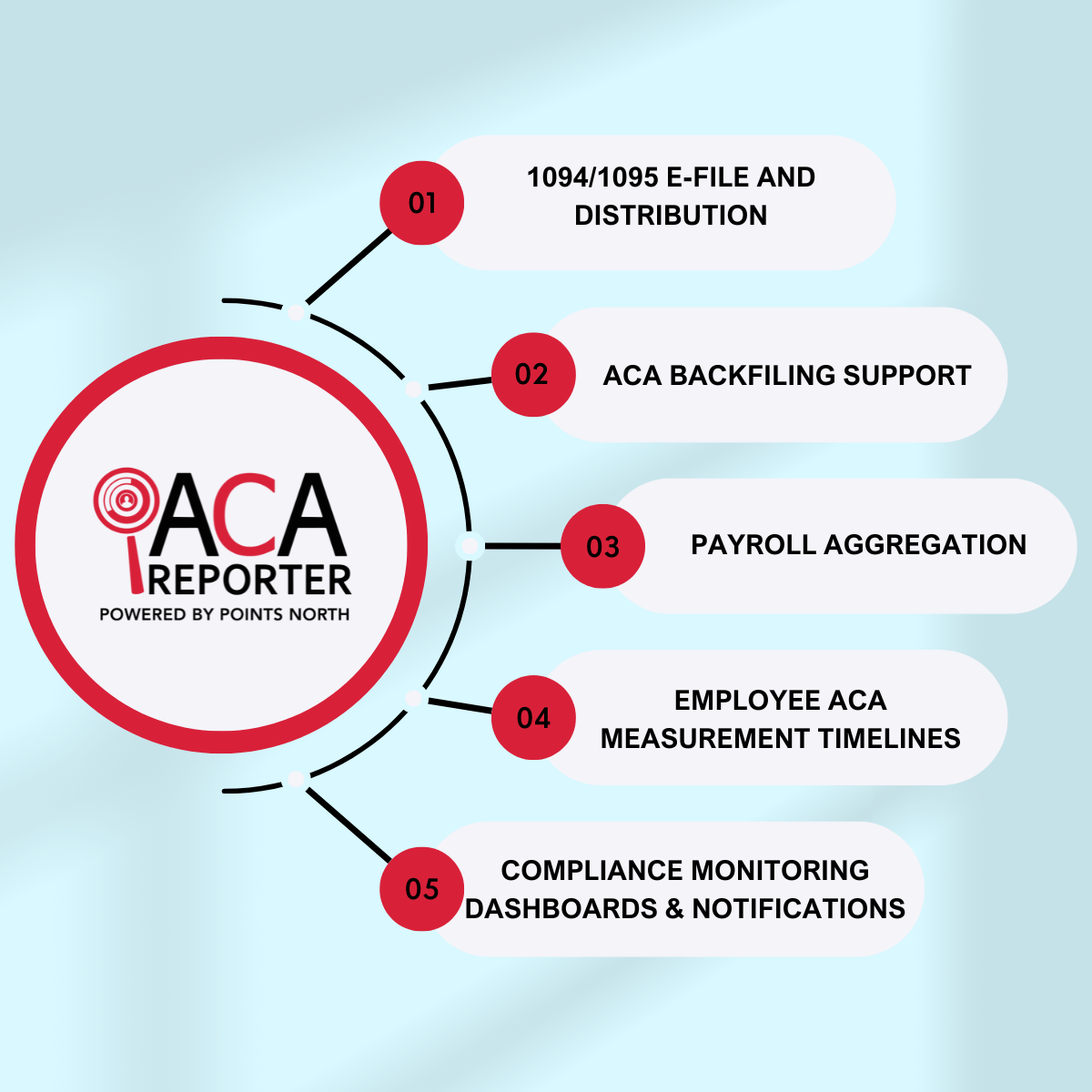Did you know around 31 million Americans have health coverage through the Affordable Care Act (ACA)? If you have not enrolled for the coverage, you should consider the benefits. From how to calculate fringe benefits to ACA Safe Harbor methods, which are used to determine affordability using employee W-2s, there’s a lot to look at. But for our purposes right now, we will focus primarily on ACA reporting requirements.
Employers with more than 50 workers need to offer health care coverage for their staff. Through the Affordable Care Act, which was enacted in 2010, numerous requirements were introduced. These requirements are confirmed as met through ACA reporting.
If you are an employer, you should be familiar with the ACA reporting process and requirements. This will ensure compliance and avoid penalties for delayed reporting.
In case you are new to ACA reporting, Points North has prepared a guide to learn more about reporting, penalties, and requirements.
What Is ACA Reporting?
ACA stands for Affordable Care Act. It is legislation to ensure all Americans have access to affordable health care.
The ACA requires companies with more than 50 full-time employees (Applicable Large Employers, or ALEs) to provide health care coverage. If you are only hiring contractors, you may still be liable for paying ACA taxes.
ACA reporting is a set of regulations that make up the health care law. The reporting system confirms that all companies provide quality health insurance plans affordably for all employees.
The ACA reporting requirements became effective for the first time in 2016. It requires you to report to the IRS details on your employee health plan.
ACA Reporting Process
ACA reporting is one of the biggest challenges for any compliance team. It requires time and attention, as mistakes can trigger penalties from the IRS.
Here is a short summary of the ACA reporting process.
Compile Your ACA Requirements
The first step to reporting is to compile all of your ACA requirements into a list. You can do this by taking stock of the information you already know. This includes the company's employees, benefits enrollment, and eligibility for coverage.
You will also need to gather information about contractors and other non-employees.
Reports Submission
Two forms are required: The two forms are called Form 1094-C and Form 1095-C.
A Form 1095 is an IRS form that reports health insurance coverage information for employees. It is filed and furnished to full-time employees in an organization with more than 50 workers.
Employees receive Form 1095-C from their healthcare provider at the end of the year (or earlier). It summarizes what medical expenses an employee has claimed on taxes. It helps employees determine whether or not you owe money to the IRS.
Employers are required to file Form 1094 C at the end of the year. The form is submitted to the IRS along with Form 1095 C.
Congress established the form in 1996 as part of the Health Insurance Portability and Accountability Act (HIPAA). The 1094-C collects information from employers regarding the coverage offered. This includes the number of people covered and cost of premiums.
The 1094 C form is not used by the IRS to determine whether your business meets minimum coverage.
The process requires employers to collect information from employees throughout the year. The employer then transmits it to the government on an annual basis.
You can submit manually or online with The Health Coverage Reporting System (HCRS).
Provide Copies to Employees
Employers must provide employees with a Summary of Benefits and Coverage (SBC). This is a document that details employees' plan coverage.
They also should provide employees with a of the copy Employer Health Insurance Annual Report (Form 1094-C). Offering employees these copies helps during tax returns.
Fines and Penalties
If you are responsible for ACA reporting in your company, here's what you need to do:
Learn about the penalties for noncompliance. This can be as much as $3,000 per employee ($3,000 x 50 employees = $150,000). There are exemptions for small businesses with fewer than 50 employees and seasonal workers.
Find an ACA reporting software solution that fits your business needs. This varies depending on the size of your company and how many employees you have.
Some companies, like Points North specialize in this service. A reliable provider will ensure compliance and protect your business from fines and penalties.
ACA Reporting Requirements
The ACA reporting requirements are in Section 6056 of the Internal Revenue Code.
The ACA reporting requirements for applicable large employers are also found in the IRS's final regulations under Section 6056. They are codified at 26 CFR Part 54 (Regulations), including the following:
Requirements for Form 1094-C
ACA requires corporations with at least 50 full-time employees to report full-time employees' coverage on IRS Form 1094-C.
The form must be filed annually by February 28 with the IRS. It should be furnished to each employee on or before January 31.
The 1094-C must be completed for each employee qualifying for health coverage.
Requirements for Form 1095-C
An employer with more than 50 full-time employees must file IRS Form 1095-C. This form determines whether employees qualify for an exemption from the ACA requirement.
All employers must report the insurance status of their workers based on information they receive from insurers and government agencies. They should fill out IRS Form 1095-C and send it to their employees in January. Employees should receive a copy by early February. If they don't, they can request a copy from your insurer.
Meet the deadlines and requirements to avoid penalties. You don't want to be on the wrong side of the IRS as it would cost you significantly.
Comply with ACA Reporting Process Today
Many American companies are switching over to the ACA reporting requirements. It's good to get familiar with what needs to be reported.
The process for ACA reporting is complex. It requires going through numerous documents, meeting deadlines, and setting requirements.
Your ACA reporting in 2022 doesn't have to be challenging. You can apply the above tools.
If you have any questions about the process of filing your ACA reports, we’ve got you covered. For 2022, the ACA reporting deadline requires paper forms to be sent to the IRS by the end of February and electronic filings are due March 31. Filings for 2023 will likely be due with similar deadlines.
At Points North, we offer innovative solutions for ACA and EEOC compliance. Our team of experts has the skills and knowledge to improve your ACA reporting experience. From how to calculate fringe benefits to ACA reporting requirements, we have the solutions you need. We recommend that you visit our ACA Reporting page to learn more.






.png)